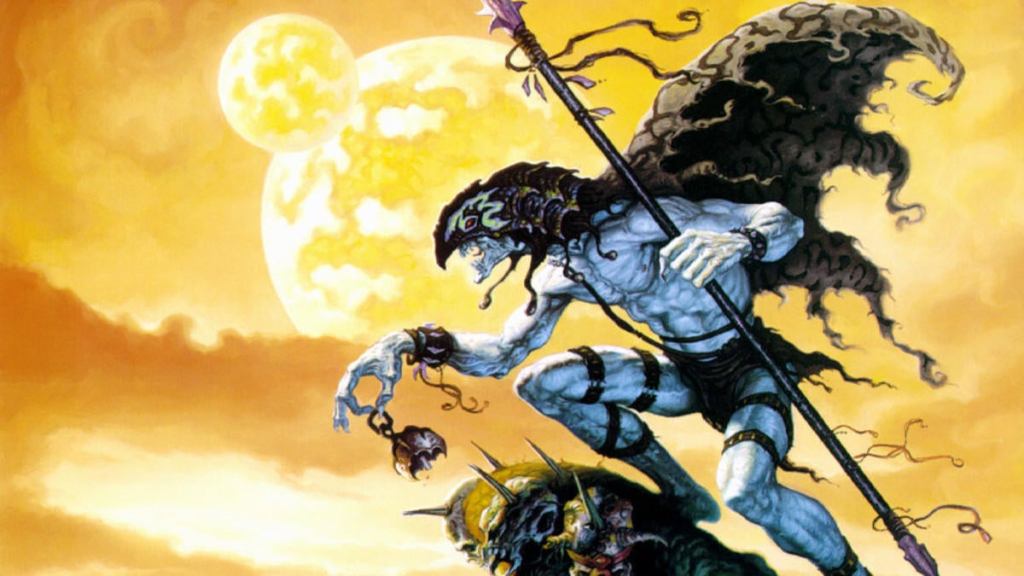When I was around 12 years old, I sat down with some of my family members to play Dungeons & Dragons for the first time. I expected something involving benevolent wizards, chivalrous knights, and sly thieves meeting in a tavern to go on an adventure, likely involving a dungeon and a dragon. Instead, my character and his fellow adventurers awoke as prisoners aboard an armored caravan. Those running the convoy kept us well fed, and it was about the time that it dawned on me we were being fattened up for an eventual slaughter that the caravan came under attack by a band of elves. Our captors freed and armed us in the hopes that we’d assist in the defense, a gamble that did not pay off for them. After finding our way out of the mobile structure that housed our cells, we managed to roll our dice well enough during some social skill checks that the elves did not kill us. Instead, they allowed us to wander the desert wastes while clinging to the slim hope that we’d reach shelter before dying of thirst or exposure.
Videos by ComicBook.com
Yes, this was Dungeons & Dragons. But it was also Dark Sun.
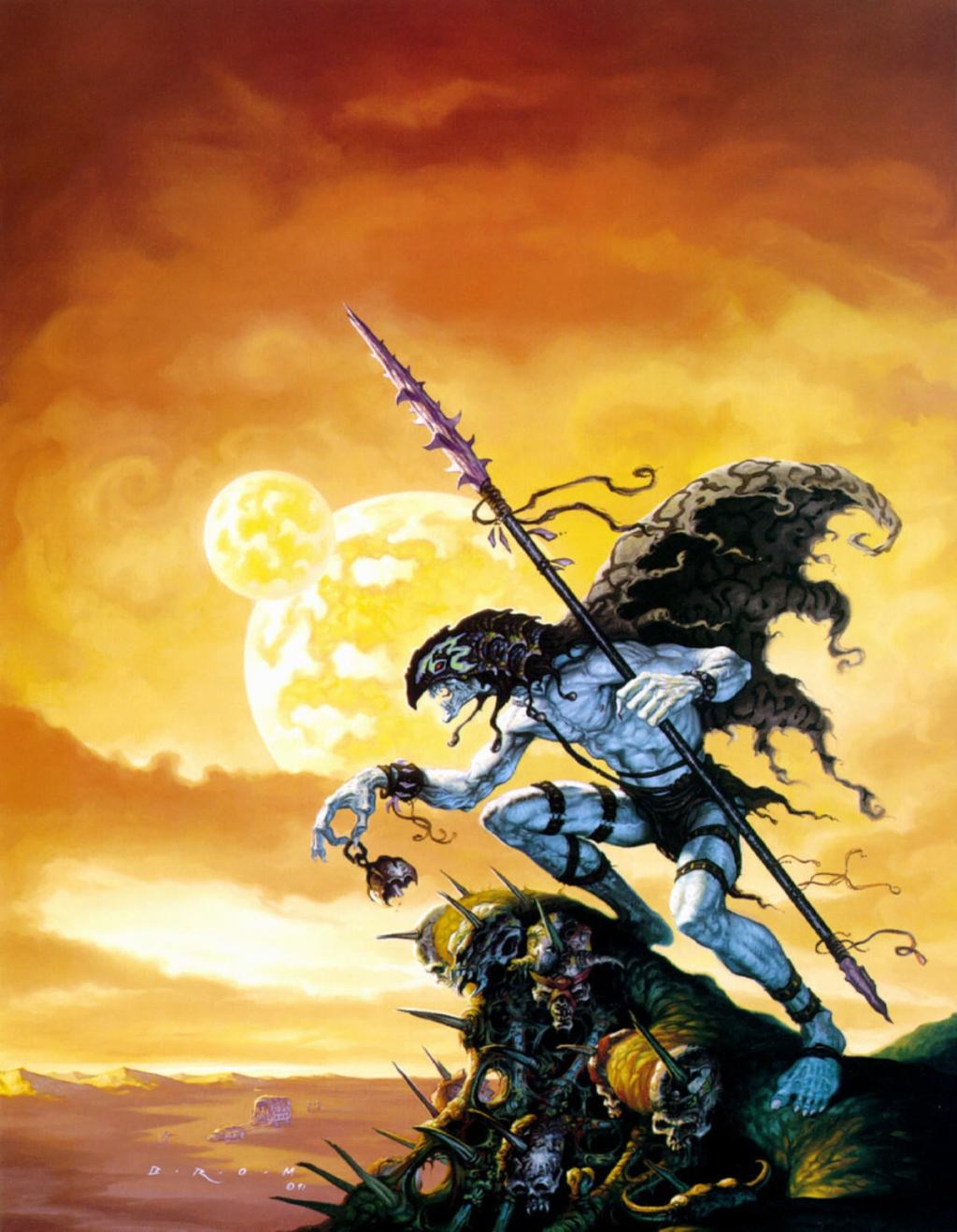
More specifically, it was “A Little Knowledge,” the introductory adventure included in the Dark Sun Boxed Set that TSR released 30 years ago this month, in October 1991. Dark Sun was hardly Dungeons & Dragons‘ first campaign setting, but it stood out from the rest. Where other D&D worlds of the time steeped themselves in familiar high fantasy tropes, Dark Sun drew more from the sword and sorcery adventures of Conan the Barbarian and John Carter of Mars. It’s even drawn comparisons to Dune for combining a desert setting with powerful psychic abilities called psionics. This uniqueness is one reason that Dark Sun maintains a cult fan following three decades later.
“There was Greyhawk, there was Dragonlance, and there was Forgotten Realms,” Tim Brown, one of Dark Sun‘s two co-creators, explains during a conversation via Skype. “And we all know that if you just file those serial numbers off, that’s Tolkien every time. So I wanted to do something really different, and I felt in that unique situation where we found ourselves, they really wanted a new setting, and we were really given a blank tablet to work with, whatever we wanted to create. And just that story in itself, of its creation, sort of leads to the rest of it.”
Another reason why Dark Sun remains popular is its dark tone, dealing with mature themes. At its best, that darkness makes the players’ heroics seem brighter. In a world where evil is the norm, almost to the point of mundanity, even the smallest act of goodness can seem monumental, even more so since such a small act could cost the would-be hero their life.
Dark Sun‘s world is called Athas. Once a fantasy world not unlike those of D&D’s other campaign settings, it is now a barren and inhospitable wasteland where surviving day-to-day is adventure enough for most people. A handful of city-states are the only pockets of civilization that remain, each ruled by the iron fist of a different sorcerer-king. These tyrants are master psionicists and defilers, a new type of wizard unique to Dark Sun. A typical campaign might involve simply surviving in the wastelands, or allying with the rebel network called the Veiled Alliance in plotting to overthrow a sorcerer-king, or venturing into the Sea of Silt or the ruins of a dead city searching for keys to Athas’ mysterious past.
Arcane magic is rare on Athas, which is one explanation for why psionics flourished. What magic exists draws on the planet itself, sapping the land of its life-giving energy. Defilers draw on this energy greedily to unleash immense power beyond what is possible of more careful spellcasters, called preservers. Reckless use of defiling magic is what turned Athas into a desert.
“I’ll take credit. Defiling magic was an invention of mine,” Brown says. “I always had felt that the basic casting of the magic in a D&D or AD&D setting just seemed a little too easy and without consequences. There should be some consequences for doing this, because it’s the most powerful thing in the game. And so I tied that into an environmental-impact situation, where you’re actually devouring the surrounding living materials to make your spells actually come off.”
“I call it ecological fantasy,” says Troy Denning, Dark Sun‘s other co-creator, over the phone. “It’s certainly one of the earlier fantasies that concerned itself with the idea of what magic might do to the ecology, and of course that’s a metaphor for what industry and rampant exploitation of our natural resources does to the natural world in the world we really live in.”
While both creators consider defiling magic Dark Sun‘s most defining aspect (Brown suggests psionics as a close second), the impetus for Dark Sun‘s creation wasn’t as lofty as creating an environmentalist fable at first. The creators recall it started with TSR desiring a new setting to take Dragonlance‘s place. For reasons neither Brown nor Denning is sure of, TSR’s executives seemed convinced that fans would soon abandon Dragonlance en masse (Dragonlance remains one of D&D’s best-loved campaign settings to this day).
TSR had a few requests for the creators. The company wanted something distinct, and they wanted it to include psionics. Beyond that, they left Brown and Denning to their own creative devices. Their pitch began with a long-standing fantasy trope, the chainmail bikini. Knowing how much D&D artists at the time tended to draw women in impractically scanty armor, a trend unlikely to change any time soon, Brown and Denning decided to make a world where that might make sense. Thus, they created Athas, where extreme heat is the norm and metal is exceptionally scarce.
Brown and Denning called the first version of their setting War World, partly inspired by the Battlestyem miniatures game, a product TSR was relaunching around the same time. Early Dark Sun releases incorporated Battlestystem scenarios, but the game never caught on and faded from use. Brown and Denning, meanwhile, had taken TSR’s desire for a distinctly different setting to heart. War World featured none of the familiar fantasy races found in D&D, such as elves and halflings.
“We initially said there aren’t going to be any elves or dragons or anything like that in this world and designed it based on the idea that all of the races and creatures that would be in the world would be new,” Denning says. “That’s why we had a lot of different kinds of far-out races that weren’t being used or used a lot in other games, but they became very common in in the Dark Sun world.”
Denning refers to Dark Sun‘s unusual playable races, such as the mantis-like humanoids called thri-kreen, the hulking half-giants, and the half-dwarven muls. Eventually, TSR got back to Brown and Denning and suggested they may have taken things too far from the familiar and that they were now worried the new setting would be too unrecognizable to attract the D&D faithful. Brown and Denning added elves and halflings to Athas, as well as a single dragon, a towering figure that walked upright on two legs and was the only being on Athas that the sorcerer-kings feared.

But the fantasy races of Dark Sun are unlike their counterparts in other settings. Rather than peaceful and contemplative forest-dwellers, elves on Athas live in nomadic tribes, running across the waste and shunning the use of riding animals. Athas’ halflings live in the last remaining wild places, such as high-up mountain forests, and are more likely to eat outsiders than invite them in for second breakfast. Similarly, familiar monsters like orcs, goblins, and ogres are absent from Athas, replaced by strange and unique creatures like the belgoi, tembo, and gith.
Another defining characteristic of Athas is that there are no gods. Certain sorcerer-kings make claims to divinity, and each bestows some power onto their templars, a class designed for Dark Sun that could cast cleric spells. Paladins are absent from the setting entirely, and clerics devote themselves to one of the four primal elements — fire, earth, wind, water — that hold sway on Athas, giving them a much different flavor than the priestly clerics of other settings.
The lack of divine presence makes sense on Athas since the plane is cut off from the D&D multiverse by a powerful dimensional barrier called the Black. This idea came about in part because Denning and Brown were pushing the boundaries of balance with Dark Sun. Their playtesting revealed that level one characters didn’t last very long on Athas. That’s why Dark Sun characters began campaigns at level three. Dark Sun characters also rolled more dice for higher starting stats and could have ability scores higher than 18, the usual maximum. (Despite all of this, the campaign still encourages players to make a “character three” of four connected characters at the start of the campaign. This ensured players had backups ready to go when their current character died.) Plus, the classes and races built specifically for Dark Sun, not to mention psionics, didn’t necessarily play well in other campaigns.
“Nobody was really sure how the game balance was going to affect 2nd edition and what it would do to the other campaign worlds,” Denning says. “So that’s where we decided that we would seal it off, that you wouldn’t be able to travel from Athas to any other AD&D campaign world. Of course, that didn’t hold. You make a rule like that, and eventually somebody undoes it, but that was one of our initial concepts.”
Whether Athas ever had gods was never officially revealed by its creators. The answer, when relevant, probably differs from game table to game table. It’s something on which even the creators don’t necessarily agree.
“In my envisioning of the environment, there are none, nor were there ever any,” Brown says. “Primarily, that was driven by, as we were creating the game, it was like, well, let’s take as many issues in other D&D environments and just turn them on their head. All the other game lines had gods, so let’s make one that just doesn’t. There are no deities out there.”
Separately, Denning says, “I will just say that Tim was wrong. We’ll leave it at that. I don’t want to make it sound like it was a serious disagreement, because it wasn’t, but Tim and I definitely had slightly different takes on what the history of the gods were, and we never spelled it out, because it wasn’t important.”
But Brown and Denning didn’t want to go in to pitch Dark Sun to TSR management without some visual aids, fearing the executives would get bored or not grasp their vision without something to show them. They had no particular artist in mind, so they ventured into TSR’s art studio, where its staff artists worked. Hanging behind one artist’s workspace was a painting of a muscular woman wearing dark armor, wielding an unusual-looking weapon, standing atop a rocky desert outcropping. Artist Gerald Brom, who is known professionally as Brom, had painted the piece at home and brought it in to adorn the studio. Denning recalls, “We came to that, looked at it, and said, ‘Oh, my god. That’s Dark Sun.’”
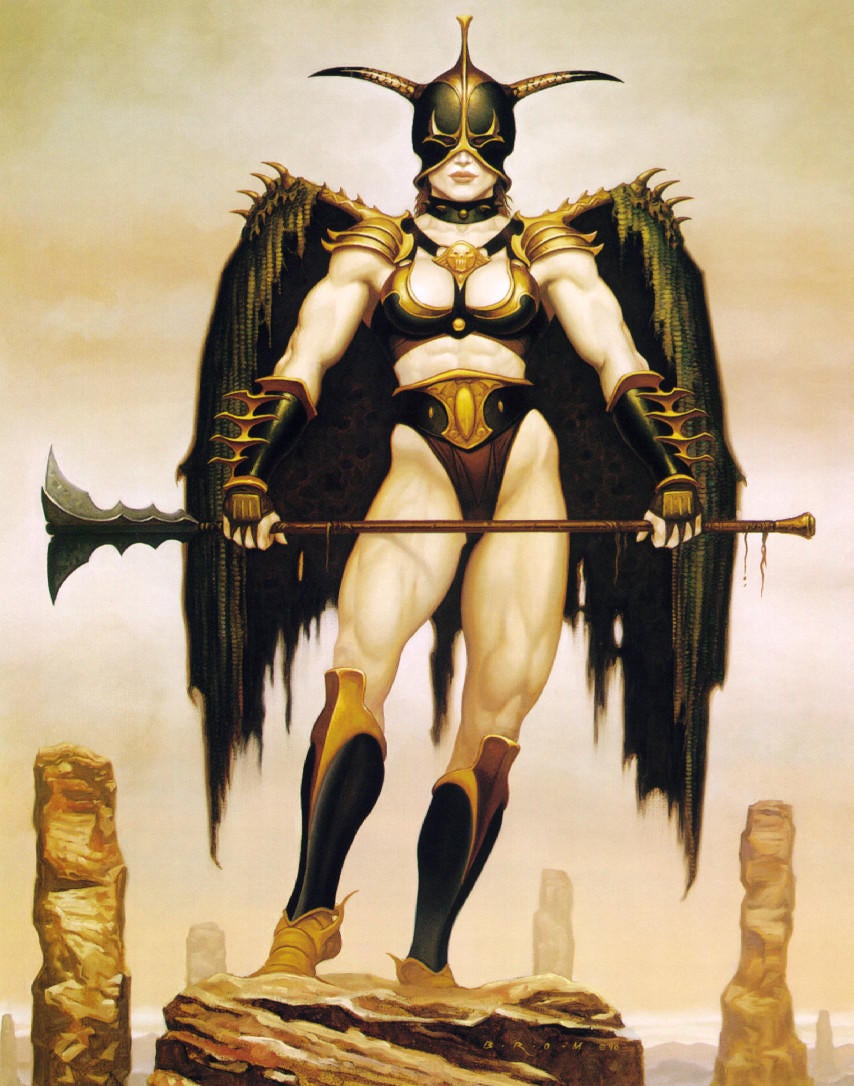
Brom was relatively new at TSR and hadn’t ended up there through any particular passion for TTRPGs. He’d tried his hand at commercial artwork and comic book covers but wasn’t having much success. He says he ended up at TSR at least in part because none of the candidates higher up on the company’s list wanted to move to Lake Geneva, Wisconsin, where the company was based. He remembers, at the time, being young and “full of snot.”
“When I first got there and I was doing a few covers for Forgotten Realms and Dragonlance, I did not fit in, so much so that the management actually pulled me in,” Brom recalls during an over-the-phone interview. “And they were like, ‘Basically, your style’s not fitting in. Can you paint more like the other artists?’ Which was intimidating and frustrating. Because number one, I wanted to bring my own voice to my work, but at the same time, I wanted to make my employers happy. So it was a little difficult there.”
Catching the eyes of creators looking for a style different from everyone else’s in the company was a blessing. Brown and Denning helped ensure that Brom put his artistic stamp on everything Dark Sun, turning it into TSR’s most artistically-driven product to date. Having Brom create the cover for every Dark Sun release also meant the line had a more cohesive look than other settings at the time. The monochromatic, brown-yellow sheen of Brom’s Dark Sun art — which clashed so much with the more colorful style of his peers at TSR to the point that management had pulled him aside — soon became Dark Sun‘s signature.
“At our insistence, the product line had a real trade dress to it, so that all the Dark Sun products would look like they belong together on the shelf, whether that’s at your home or in the store,” Brown explains. “In those days, if you took all the Greyhawk products and lined them up, spine out, it was a mish-mosh mess of craziness. No one was paying any attention to what this stuff would appear like on the shelf. And we worked with the graphics people extensively just to make sure that all the stuff looked coherent. And I think that was a real success.”
That first painting inspired the creation of Neeva, one of the principal characters in Dark Sun fiction. This occurrence helped define the working relationship Brom had with Denning and Brown. The way most TTRPG illustration works is that the designers come up with an idea, and then they put in an art requisition asking an artist to create what they’ve envisioned. With Dark Sun, Brom would just as often come up with something himself and, after painting it, show it to Brown and Denning, who would concoct a way to work it into Dark Sun. The designers provided Brom with the big picture, and he eagerly filled the gaps himself.
“Less information gave me more freedom,” Brom says. “What they encouraged me to do, where I feel I really contributed, was they would give me this broad outline. The characters wouldn’t have been designed. The world wasn’t really visually designed. So they were just like, ‘Just put stuff in there, whatever cool thing comes to mind. And we’ll just write it into the scenario of the world. So if there’s a dragon king, well, nobody knows what a dragon king looks like. So I make a dragon king. If there’s a ship that goes across the Silt Sea, I make this. I add this. I make this weapon. And so, that’s the part that I contributed, that I got to just let my imagination run wild. And they would take stuff that I would put in these paintings and write them in the stories. It went back and forth. The cool thing was, I would create something visually, and then they would write it up. And then they would come back and tell me, ‘Oh, this inspired this idea, and this is this.’ And I’d be like, ‘Oh, that’s so cool.’ And then I would put that back into the art.
“I feel that art and game creation by committee can kill the soul to some degree,” he continues. “But we were really fortunate. And it was a small group of us. And it seemed like, I guess there was so much to do, that nobody was trying to micromanage, there weren’t egos, so I felt there was a great sense of just creatively working together. I felt inspired by them. And I hope in turn that they were inspired by the work I was doing.”
Eventually, it all came together. Dark Sun was released and, despite some initial doubts, proved a hit with Dungeons & Dragons players.
“I think that the initial purchase order was going to be like 15,000 units,” Brown recalls. “That’s the number, which was pretty embarrassing.” But then Brom’s promotional artwork showed up in Dragon magazine. TSR also sent out some prints of Brom’s Dark Sun artwork to game stores. At that point, “It went through the roof,” Brown says. “This was pre-internet, so we were getting mostly snail mail saying, ‘This is great. We can’t wait to see this.’ And the orders coming in from distributors kept going up and up and up until it actually smashed some kind of a first-print record. I think we ended up doing 70,000 sets of the first box, right out of the gate, and that was just gone, and it had to go to reprint.”
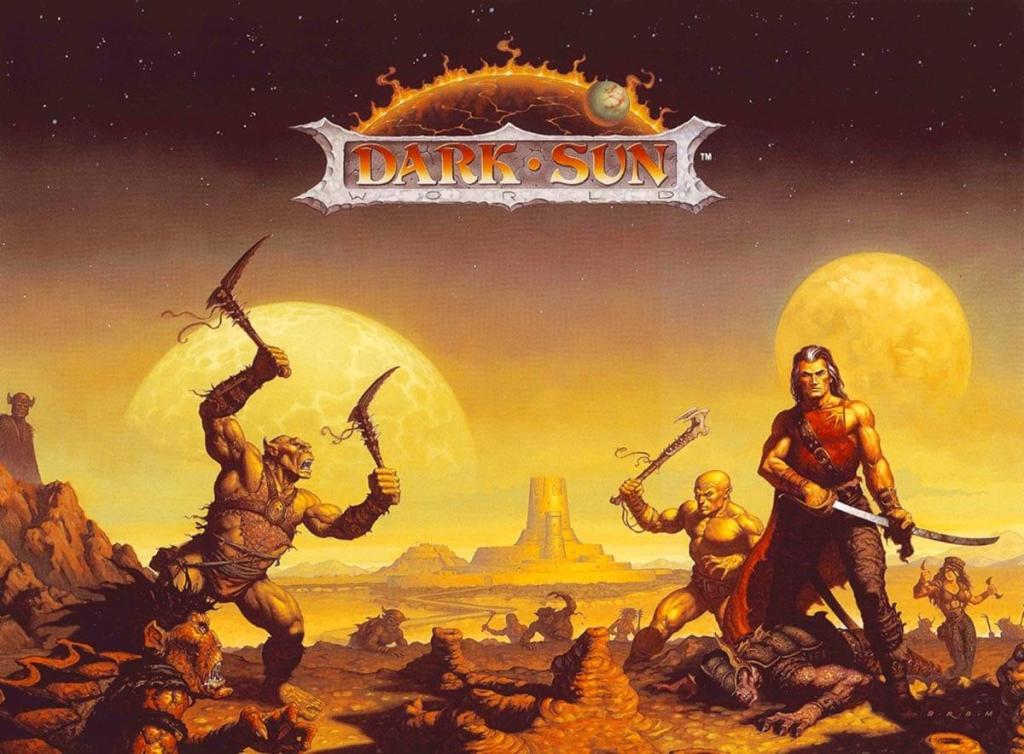
Dark Sun continued to be a success for years. TSR supported the original Dark Sun Boxed Set with adventure modules, monster folios, and additional sourcebooks. Something unique about Dark Sun‘s supplemental releases, the adventures, in particular, was that they told a story. Dark Sun engaged in a metaplot, an overarching narrative spanning all of the setting’s materials. The concept of metaplot has gone in and out of fashion over the years. D&D had dabbled in it previously. The company had enlisted Denning (co-writing with Scott Ciencin under the pen name Richard Awlinson) to write The Avatar Trilogy. These novels explain the changes made to Forgotten Realms lore in its Advanced Dungeons & Dragons iteration.
But Dark Sun went much further with the concept. The very first adventure module, Freedom, saw a group of rebels assassinate Kalak, one of the sorcerer-kings detailed in the Dark Sun Boxed Set, thus turning the city-state of Tyr into the first free region in known Athasian history. Mary Kirchoff, then head of the D&D book line, recruited Denning to chronicle that rebel band’s adventures in a series of Dark Sun novels called The Prism Pentad. The series revealed new information about Athas’ history and tied into future Dark Sun adventure modules as it continued to alter the world as described in the boxed set.
These progressions eventually led to TSR putting into production an updated boxed set to get new players up to speed with what Athas was like after The Prism Pentad‘s events. By then, Denning had left game design to become a full-time novelist, eventually contributing several novels to the Star Wars expanded universe. But before that, the new head of D&D’s novel line, Brian Thomsen, reassigned Denning to work on a Planescape novel.
“I think, at the time, he was having a little bit of trouble dealing with the stars that Mary had made,” Denning explains. “When somebody gets really successful, they want more money and more perks and more control over their projects, and that was causing him a few headaches with some of the people who had succeeded in the other worlds, and so I think he was trying to say, ‘Okay. I’m not going to have another one.’ So he moved me off of Dark Sun.”
Brown had moved into a more managerial position, and Brom had left TSR to return to freelance work. It ultimately fell to Bill Slavicsek to head up the new boxed set. Slavicsek had written for Dark Sun previously and would remain a significant figure in Dungeons & Dragons‘ development for years to come.
TSR published Dark Sun Campaign Setting, Expanded and Revised in 1995. In addition to integrating plot points from Denning’s novels, it and its supporting sourcebooks also took the setting in some new directions. Where all of the original Dark Sun Boxed Set focused on a relatively small, isolated area of Athas called the Tablelands, the revised edition opened up a pathway in the west, where a thri-kreen empire existed. It also unveiled a hidden utopia in the east created by powerful psionicists. Multiple sorcerer-kings had died, and there was a new sense of hope spreading on Athas.
“To my way of mind, it drifted closer to being more of a standard fantasy setting than we ever would have allowed or done,” Denning says. “But that’s just the nature of different people’s visions and people trying to always find the fresh new thing to do, and one of the fresh new things for Dark Sun was, ‘Oh, okay. Let’s introduce more metal. Let’s allow people to travel to other planes from Dark Sun,’ and that kind of thing, which was not anything that I had ever expected or intended to happen, but not necessarily saying it’s a bad thing. It’s just different. It’s not the Troy thing, I guess, is the way to say it.”
For years, Dark Sun was one of TSR’s top sellers, so players were surprised when it ended. The setting wasn’t present in the company’s 1996 catalog. A year later, Wizards of the Coast purchased TSR and Dungeons & Dragons along with it. Wizards of the Coast had a more streamlined vision for D&D. Believing TSR had spread itself too thin supporting its many campaign settings, Wizards of the Coast offered few in comparison when it released the game’s 3rd edition. Dark Sun was not one of them.
While Wizards didn’t offer any official Dark Sun content, Paizo in 2004 had designer David Noonan create an updated take on the setting, published in Dragon and Dungeon magazines (which Paizo operated at the time). Through the Open Game Licence, the fan community at Athas.org created another 3rd edition update of Dark Sun and released it for free on the website. The group even completed two Dark Sun sourcebooks TSR abandoned at the end of its run, Dregoth Ascending and Terrors of the Dead Lands. Wizards of the Coast officially revisited Athas in 2010, with lead designer Rich Baker and his team updating the setting for the 4th edition of Dungeons & Dragons (Brom says Wizards of the Coast invited him to contribute new artwork to this edition but he declined).
Of these updates, Athas.org‘s stayed most faithful to the original setting, picking up where the revised box set left off. The others tried to be more inclusive of non-Dark Sun material. Paizo’s version added paladins into the mix, and both added newer races. Both also tried to restore some of Dark Sun‘s original flavor. The Paizo version moved the timeline up 300 years to a point where the Tablelands’ balance of power mainly had reverted to what it had been before The Prism Pentad. The 4th edition version rolled the continuity back to just after Kalak’s demise in Freedom.
There’s been no official update for Dark Sun in Dungeons & Dragons 5th edition, though the current core rulebooks mention Athas. The setting was referred to again in the early playtest material for the updated psionics classes. The adventure . But Wizards of the Coast remains officially silent on Dark Sun‘s future, including when reached for comment for this article.
“What they did for the 4th edition didn’t seem terribly inspired, from my point of view,” Brown says. “And now it’s basically in a drawer, so that’s always been a bit disappointing.” In 2013, Brown attempted to fill that void by launching a successful Kickstarter for a spiritual successor to Dark Sun called Dragon Kings, playable with several different game systems, including D&D 5th edition.
Brown also says that he’s part of a group of people who have offered to purchase the rights to Dark Sun from Wizards of the Coast on multiple occasions. However, Brown says his group “have been rebuffed every time. [Wizards of the Coast] just want nothing to do with that setting now.” (When reached for comment, Wizards of the Coast said it could neither verify nor deny Brown’s statements).
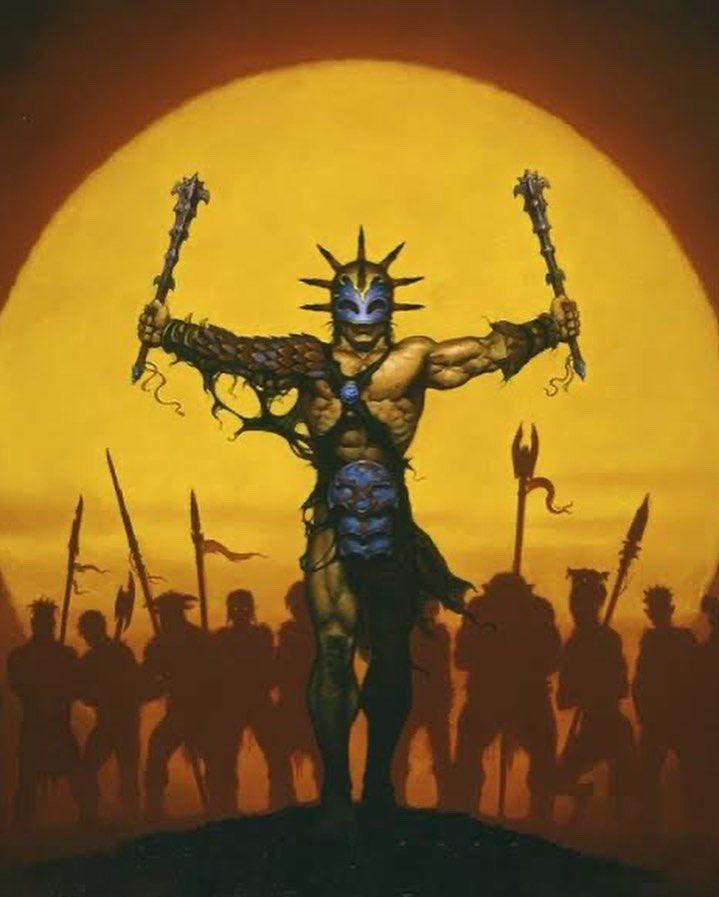
Considering how much anxiety now exists around climate change and widespread frustration among the public with entrenched institutions, one might think Dark Sun‘s themes of power, corruption, revolution, and ecological collapse seem more relevant now than ever. Brown wonders if Wizards of the Coast is reluctant to revisit Dark Sun due to some of the setting’s other complicated elements. That caravan I mentioned earlier? That was a slave caravan. Slavery is commonplace on Athas and, though it is not race-based, some TTRPG players feel that such an abhorrent practice has no place in the hobby.
Similarly, Wizards of the Coast has in recent years been reckoning with how Dungeons & Dragons historically treated race. Wizards of the Coast has tweaked the game’s race rules and has attempted to address issues of stereotyping in its depictions of the Drow and Vistani. Dark Sun has drawn some similar criticisms.
“Those are all pretty valid concerns,” Denning says. “I don’t think slavery was ever presented as being an institution that was anything but evil in Dark Sun, but it was presented as being existent, and I think that that can run into problems. When you’re trying to run a campaign, you don’t have the ability to put your mind and your sensibilities into the heart of every DM who’s running it, so there’s certainly the potential for somebody to misuse certain thematic aspects of it.”
He continues, “The elves would be, I think, a good example of how a character could be stereotyped and it could end up being racially insensitive, because the elves were presented, in my mind, as wild nomads who had a whole different belief system about society. They viewed property as being communal and not being owned individually, which made them, in the eyes of city dwellers, seem like, ‘Well, that’s just a bunch of people that you really can’t trust. You can’t be around them, because they’re going to take your wagon as their own. They’re just going to get in it and drive off with it.’ I think that’s certainly a place where if somebody wasn’t being careful, that they could miscast them, but I think that’s probably true in most story concepts.”
When it comes to Wizards of the Coasts’ attempts to rectify these kinds of issues, Denning says, “I think this is a good thing, but I think that now fiction of all sorts is being more careful to not stereotype anybody, any race or even species, in a negative way, and I think that that’s smart. It creates more interesting characters, to begin with, and so on that basis alone, it’s a good thing to have happen. I think if they reissued Dark Sun and asked me to do it, that’s certainly something that I would want to take a very careful look at and make sure that the stereotypes were not being used negatively and that we were avoiding stereotypes as much as possible. I’m proud of everything I did in Dark Sun, but that’s not to say that I couldn’t do it better now.”
Brown, separately, echoes much of what Denning says regarding elements like slavery in Dark Sun. “We always thought, we’ll put this in the game, but we’re the people working against it,” he says. He remembers having, at the time, recently seen Spartacus, the film from 1960. It inspired him to create a setting where players can fight in a version of the Third Servile War (the original Dark Sun Boxed Set introduced the gladiator class to the game, and gladiator arenas are fixtures of every city-state). But Brown remains of two minds about whether Dark Sun could successfully be updated to address those issues adequately.
“The optimistic me says yeah, I think it could be,” Brown says. “If you massage those things right and get an awful lot of coaching in your manuscript and, ‘Here’s how you should treat these while you play, and nobody’s saying these are great things. They are terrible things to be fought against. Stand against them. That’s what the heroes do.’ So the optimistic me says yes.”
On the other hand, Brown, who left social media years ago, isn’t sure that the attempt is worth the risk considering the tenor of online discourse. “The old saying is there’s no such thing as bad publicity,” he says. “Well, there is bad publicity today, and that would be bad publicity. I think, for the most part, you’d spend all your time apologizing and complaining and not making the game. It’d be very difficult. Very difficult.”
But while many fans would welcome a new official edition of Dark Sun, it may genuinely not be necessary. As mentioned, when Wizards of the Coast chose not to support Dark Sun in D&D’s 3rd edition, Athas.org came along to fill that void. Now, through D&D Beyond, the Dungeon Masters Guild, and various other online websites and communities, it’s easier than ever to share ideas for a new Dark Sun. With a simple web search, it’s easy to find playable fan conversions of Dark Sun for D&D’s 5th edition. And those original Dark Sun materials that Denning, Brown, and Brom worked on are easily obtainable now in legal PDF format.
In other words, Dark Sun remains available to those who seek it out. To this day, there’s no D&D setting like it, nor one more in need of heroes. Adventure still awaits on the burnt world of Athas to those willing to accept the challenge.
Editor’s note: Edits were made to this story post-publication to correct minor typos and stylistic inconsistencies.

